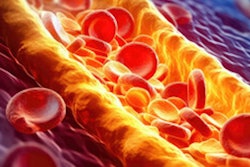
CHICAGO - Low-dose CT lung screening exams aren't just useful for finding lung cancer. With help from an artificial intelligence (AI) algorithm, these studies can also be used for opportunistic screening for heart disease, according to research presented Tuesday at the RSNA 2019 meeting.
A research team from Brigham and Women's Hospital (BWH) and Massachusetts General Hospital (MGH) in Boston trained a deep-learning algorithm to automatically measure coronary artery calcium (CAC) on 1,600 cardiac CT exams with manual measurements of CAC. After then testing the model on nearly 15,000 participants in the CT scans on the National Lung Screening Trial (NLST), they found a significant association between the algorithm-derived calcium scores and death from heart disease over a median follow-up of 6.5 years.
 Roman Zeleznik of the Brigham and Women's Hospital and Dana-Farber Cancer Institute in Boston.
Roman Zeleznik of the Brigham and Women's Hospital and Dana-Farber Cancer Institute in Boston."Automated CAC corresponded closely to human readers and was strongly associated with all-cause and cardiovascular mortality in a large multicenter cohort of NSLT participants having lung screening," wrote the authors, led by Roman Zeleznik of the Artificial Intelligence in Medicine (AIM) Program at BWH and Dana-Farber Cancer Institute. "Automated quantification of coronary calcium using existing lung screening CTs identifies persons at high and low risk to guide cardiovascular preventions."
Despite its prognostic value, CAC is not routinely measured in low-dose CT lung screening, as these measurements require dedicated software and add interpretation time, according to the researchers.
Their automated coronary calcium quantification system, however, could be used to segregate people into high- and low-risk groups. The researchers noted that the deep-learning system runs in the background and adds no time to the exam.
"If our tool detects a lot of coronary artery calcium in a patient, then maybe we can send that patient to a specialist for follow up," Zeleznik said in a statement. "This would make it easier for patients to get appropriate treatment."
What's more, it could be a boon to research, enabling much faster evaluation of a large number of patients, according to the authors. Via further testing in the Prospective Multicenter Imaging Study for Evaluation of Chest Pain (PROMISE) trial and the Rule Out Myocardial Ischemia/Infarction Using Computer-Assisted Tomography (ROMICAT) trial, the model has also been shown to be effective in people with stable and acute chest pain, they said.
"We have a tool that in the future can be used on almost every chest scan to generate very clinically relevant information for a large number of patients," said co-author Hugo Aerts, PhD, director of the AIM Program at BWH.





















